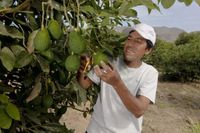As Cinco de Mayo approaches, the demand for avocados in the United States is set to skyrocket, with the APEAM A.C. (Asociación de Productores y Empacadores Exportadores de Aguacate de México) announcing the shipment of 96,379 tons of Mexican avocados to the U.S. market. This celebration, which symbolizes Mexican cultural pride, has become one of the peak seasons for avocado consumption, alongside the Super Bowl. Iconic dishes like guacamole have solidified avocados' place in American culinary traditions during this festive period.
The increasing demand for avocados during Cinco de Mayo presents a crucial opportunity to enhance the presence of Mexican avocados in one of the world’s most competitive markets. This dynamic not only positions the fruit as a symbol of cultural heritage but also provides significant economic benefits for thousands of families involved in production, packing, and agricultural labor in Michoacán and Jalisco. Each avocado that reaches American tables carries a story of effort, pride, and responsibility.
In a collaborative effort, the APEAM, together with Avocados From Mexico (AFM), the Avo Institute, and The Mexican Hass Avocado Importer Association (MHAIA), has embarked on the Route of Sustainability. This initiative promotes sustainable agricultural practices, environmental protection, and the well-being of communities involved in avocado production. The association reaffirms its commitment to a fairer, greener, and more prosperous future for all stakeholders in the avocado supply chain.
Meanwhile, in Peru, the export of avocados has emerged as a key economic driver in the province of Huarmey. Currently, there are 1,200 hectares of avocado trees, supporting 664 families in the region. Since 2017, with the support of Antamina, a project focused on good agricultural practices and responsible pesticide use has been underway. This initiative has led to the introduction of high-genetic-value seedlings and drip irrigation systems, enhancing the quality of the crops.
Local authorities, including the Provincial Municipality of Huarmey, SENASA, and the Agricultural Agency, have partnered with Antamina and ACUDIP to promote sustainability, fair trade, and a direct commercialization cycle from producers to exporters. Notably, several exporting companies have been invited to participate, including Westfalia Fruit Perú, Fruglobe S.A.C, Añay Peruvian Fruits, Marand company S.A.C, Valle San Miguel, and Corporación Tierra Brava S.A.C.
The latter, Corporación Tierra Brava S.A.C., has played a vital role in marketing avocados in the international market, managing logistics and transportation from production fields to Huaral, and facilitating shipments from the mega port of Chancay to Shanghai. This growing international demand for avocados has opened new business opportunities for local farmers.
Investments in agricultural technology, irrigation systems, and technical training have significantly improved crop quality, enabling access to markets in the United States, the Netherlands, Spain, and China. The success of avocado exports from Huarmey exemplifies how agricultural innovation can transform local economies and provide sustainable livelihoods for families.
As Cinco de Mayo festivities draw near, the U.S. prepares for a surge in avocado consumption, reflecting the deepening ties between Mexican agriculture and American culinary culture. The avocado, once a regional delicacy, has now become a staple in American households, particularly during celebrations that honor Mexican heritage. This year’s shipment of over 96,000 tons underscores the importance of avocados not just as a food item but as a cultural bridge between nations.
The commitment to sustainability within the avocado industry is also noteworthy. Efforts by organizations like APEAM and their partners emphasize the importance of environmentally responsible practices. This approach not only benefits the environment but also enhances the quality of avocados, ensuring that consumers receive a product that is both delicious and ethically sourced.
In Huarmey, the success of avocado cultivation has led to a ripple effect in the local economy. Farmers are not only improving their livelihoods but also contributing to the broader economic landscape of Peru. The collaboration between local authorities and agricultural organizations exemplifies a model of development that prioritizes sustainability and fair trade.
As both Mexico and Peru continue to navigate the complexities of international markets, the avocado stands as a testament to the potential of agricultural innovation and cultural exchange. Whether it’s served as guacamole at a Cinco de Mayo party or enjoyed in a salad in Shanghai, the avocado represents more than just a food item; it embodies a story of heritage, sustainability, and economic empowerment.
As we celebrate Cinco de Mayo this year, let’s take a moment to appreciate the journey of the avocado from the orchards of Michoacán and Huarmey to our tables, recognizing the hard work and dedication of the farmers who make it possible. Their efforts not only enrich our culinary experiences but also strengthen the bonds between cultures, fostering a deeper understanding and appreciation of the diverse agricultural practices that sustain our global community.




